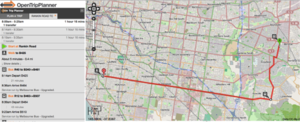
"Public Transport Informatics (PTI)" is a still developing concept:- drawing from the general concept of 'Informatics', PTI refers to the practice of generating, assessing, interpreting and re-purposing information about public transport networks and systems to be useful for human understanding and action. It can thus be considered a more specific form of Transport informatics but concentrating on aspects of multi-modal public transport systems.
Introduction[edit | edit source]
Public Transport systems are very rich in information, and traditional ways of gathering such information such as human-administered surveys are now being complemented by increasingly low-cost information technologies such as sensors, Global Positioning System (wikipedia:GPS) navigation devices in vehicles, even potentially mobile phone locations, etc. The growth of the internet infrastructure means such information can also be more widely spread and utilised.
Once collected, this information can be potentially put to useful purposes, such as supporting analysis and display through a GIS system, or applications to support people to access transport systems more easily via smartphones or on-street displays. To allow a broader section of society to access relevant data, governments need to set up and pursue Open data policies in respect to data they collect and curate, and/or mandate and set up appropriate access by other parties to data collected by private groups. These type of datasets can complement well 'crowd-sourced' or community-developed resources such as Openstreetmap.
In the area of Public transport, the development and uptake of the General Transit Feed Specification (GTFS) format has been one example of a large spur to the potential of transport informatics.
Here on Appropedia, we are interested in the application of Informatics research and development to public transport because of its potential significant potential to make public transport more attractive to private motorised transport, as part of a necessary move to more Sustainable cities. This includes, as well as making systems more attractive to users using smartphones or real-time updated displays of transit vehicle expected arrival times, investigating systems that support best practices of public transport systems planning, such as Integrated multimodal network planning, and Public transport prioritisation - and spreading these innovations globally as effectively as possible.
See also[edit | edit source]
- Urban informatics
- Transport informatics
- Community Informatics
- Open Source Transport Informatics tools Project on Appropedia to review open source Transport informatics software: particularly those relevant to public transport planning.
- The Open Source Sustainable Transport Informatics Platform (OSSTIP) project, to investigate the possibility of building a platform based on existing Open source software tools to assist in understanding existing public transport systems, and communicating the benefits of potential improvements.
External Links[edit | edit source]
- The Ideas in Transit Innovation Wiki and related Project page has lots of good information at the intersection of improving public transit and information technology.
- "Building a Map for the Insane Public Transit of Bangladesh (A Kickstarter project)
- Proposal for an 'Open Transportation Technology' StackExchange site - as of Feb 2014, unfortunately closed due to lack of commitment.
- Public-transport focused extensions to the OpenStreetMap platform: